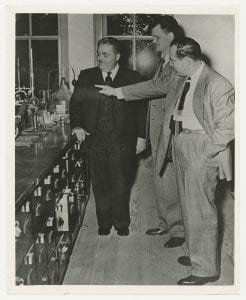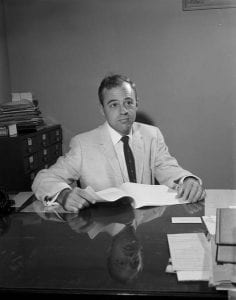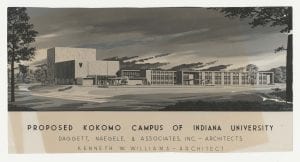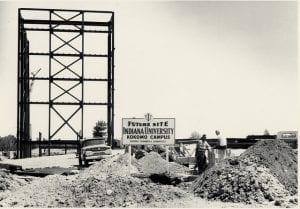By: Hannah Bourne, Bicentennial Intern, Class of 2019, History & Political Science and Communication, Kokomo
For part one of this blog, please visit: https://blogs.iu.edu/bicentennialblogs/2018/07/05/the-creation-of-kokomo-junior-college/
The Merger
In 1945, Indiana University purchased the Kokomo Junior College and established the Kokomo Extension Center at 508 West Taylor Street. The merger was a bittersweet affair. Within his correspondence, Dr. Hurd Allyn Drake, president of the Kokomo Junior College, expressed his sadness at seeing the college come to an end:
“Regretful as I am to admit it, the general public does not seem wide awake to the advantages of our own college in our own city, and so it seemed best to enter into this merger…I believe we shall have benefits for the community from the Indiana University Center, though I do not conceal my belief that it cannot equal that of a situation where faculty and students live together in such a close fellowship as we have enjoyed in the College.”[1]
The merger would provide the financial stability and resources that the Kokomo Junior College desperately needed. However, the new IU Extension Center faced many of the same challenges as its predecessor.
Virgil Hunt was appointed as the first director of the Extension Center and he immediately began making efforts to recruit a student body, find faculty members, and assemble the course list for the approaching Fall semester.[2] Fortunately, Hunt’s efforts were met with success and the numbers soon inflated beyond what the 508 West Taylor Street location could hold.

The Seiberling Mansion
In 1947, the Extension Center experienced its first of two major transitions. The campus moved to what is likely the most unusual regional campus location in IU history: a stately Victorian residence located in the Old Silk Stocking district of Kokomo called the Seiberling-Kingston Mansion.[3]
Soon after, in 1952, IU purchased the Mark Brown (or Elliot House) next door. The Elliot House contained administrative offices, a library, a bookstore, and faculty offices. The Elliot House’s carriage house was used as a meeting space and an art studio.

The Science Building, located in the Seiberling Mansion’s carriage house, provided classrooms and a laboratory space.[4] With a chemistry lab in the carriage house, the beautiful old residences became a place for Kokomo citizens and GIs returning from World War II to receive a quality education at an affordable price, close to home.[5]

New Leadership
In 1956, Virgil Hunt moved from his position as director of the IU Extension Center at Kokomo to serve as the dean of IUPUI. Hunt had cultivated strong community support for the IU Center during his time as director and built a strong foundation for the next director, Smith Higgins.
Higgins served as director until 1959, when he became the dean of the IU Extension Division, distinguishing himself as a champion of the IU regional campus system over the course of his career.[6]
He was succeeded by the center’s academic counselor, Victor Bogle, who had faithfully served the campus in a variety of ways under Smith Higgins. Bogle worked as a student recruiter, registrar, director of student activities, and handled whatever Higgins was unable to tackle himself–in addition to his duties as counselor.
The three transitions in leadership were made easier through the assistance of two capable women: Barbara Dutton, the secretary-office manager, and Helen Toney, manager of business operations.[7]

Growth and Change
Eventually, the Indiana University Kokomo Extension Center began to outgrow the 1200 W. Sycamore St. campus. Maintenance costs on the deteriorating mansion (which they called the Recitation Building) grew higher and higher. Classroom space was highly limited and quickly running out as enrollment rose.
Out of the 14 available classrooms, only two were able to seat up to 35 students, and only two more could seat more than 40. Thus, 10 of the 14 classrooms could only support small class sizes. The center library was deemed unsatisfactory, offering too little shelving space for materials, and no room for students to study.
In a letter to Victor Bogle, Smith Higgins wrote, “The library holdings are very meager, partly because of limited space, and must be expanded to meet the academic standards of the University.”[8]

One of the greatest complaints about the West Sycamore Street campus was a lack of parking for the center’s growing population.[9] According to a report conducted by Dr. George F. Bloom and Dr. A.M. Weimer, the university had three options for the Kokomo Center: “First, remain at the present location and provide for varying degrees of improvement of available facilities, second, move to another downtown location, or third, move to a peripheral location.”[10]
In the memorandum to IU president Herman Wells, the two stated, “We found all of these people to be highly cooperative. No one appeared to have a strong opinion in regard to the future development of the center…In short, no one seemed to be trying to ‘sell’ us anything.”[11] In fact, Drs. Bloom and Weimer were slightly mistaken in their assessment.
As their correspondence reveals, the people of Kokomo–particularly Dow Richardson, editor of The Kokomo Tribune–were quite devoted to the idea of expanding the center and passionate about seeing the expansion succeed. Buying land downtown seemed too expensive. Some of the more interesting location suggestions included Kokomo’s Foster Park and draining a huge quarry to build a hotel and place the center on top, with the quarry providing access to subterranean parking. Neither of these were deemed viable options.
Though Bloom and Weimer stressed that they did not ever expect the center to develop as a major unit in IU’s expansion system, they did see the potential for more growth, especially under the capable leadership of Dr. Smith Higgins.
A New Campus
In 1960, Dow Richardson wrote to Victor Bogle stating: “Some interesting developments have arisen in the possibility of re-locating the I.U. Extension Center in Kokomo…The point may be here where our committee can submit a recommended program of action to the University and expect action on it.”[12] When it was determined by President Wells that the IU Extension Center should be expanded, a Chamber of Commerce committee was established to assist the university in finding a suitable location for the new campus.
After much deliberation, a 24-acre tract of land belonging to Mr. and Mrs. Claude Mills was selected as the best spot for the Kokomo Center to expand, thrive, and grow.[13] Another exciting addition to the construction of the new IU Extension Center involved a $225,000 gift from the estate of IU alumna Mrs. Cressy Thomas Havens, who had a dream of building a beautiful auditorium to house the arts, theater, and music for the Kokomo community to enjoy.

However, the gift was not enough to fund the construction of such a project, so the executors of her estate approached Indiana University in hopes that they would be willing to partner and supplement the funds to create an auditorium. The auditorium became the cultural centerpiece of the first new university building in Kokomo: The Main Building.[14]
IU president Elvis J. Stahr broke ground on the brand-new campus location at 2300 S. Washington St. on December 6, 1963 and the Main Building of the Indiana University Kokomo Campus was officially dedicated on November 12, 1965.[15]

Notes
[1] KJC Correspondence 1945. Letter to Mrs. Blanch Gorton from Dr. Hurd Allyn Drake, August 11, 1945. Indiana University Kokomo Archives.
[2] Dow Richardson, Going to College at Home: Forty Years of Higher Education in Kokomo 1945-1985 (Bloomington, IN: Indiana University Publications, 1985), 10.
[3] Linda Herman Ferries, Dr. Susanne S. Ridlen, Dr. Allen I. Safianow, and Dr. Timothy J. Sehr, Coming of Age: 50 Years of Higher Education in Kokomo 1945-1995 (Kokomo, IN: The Trustees of Indiana University, 1997), 13.
[4] Main Building / Correspondence. To Dr. Victor Bogle from Dr. Smith Higgins. “Future Building Plans for the Kokomo Center.” August 12, 1959. Indiana University Kokomo Archives.
[5] Ferries et al., Coming of Age, 9.
[6] Richardson, Home, 13.
[7] Ibid., 15.
[8] Main Building / Correspondence. To Dr. Victor Bogle from Dr. Smith Higgins. “Future Building Plans for the Kokomo Center.” August 12, 1959. Indiana University Kokomo Archives.
[9] Main Building / Correspondence. Letter to President Herman B Wells from Dow Richardson. January 29, 1960. Indiana University Kokomo Archives.
[10] Main Building / Correspondence. Dr. Bloom and Dr. Weimer to President Herman B Wells. “Memorandum: Report on Extension Center at Kokomo.” IU Kokomo Archives.
[11] Ibid.
[12] Main Building / Correspondence. Dow Richardon to Dr. Victor Bogle. January 13, 1960. IU Kokomo Archives.
[13] Richardson, Home, 16.
[14] Ibid., 17.
[15] Ibid., 16-17.